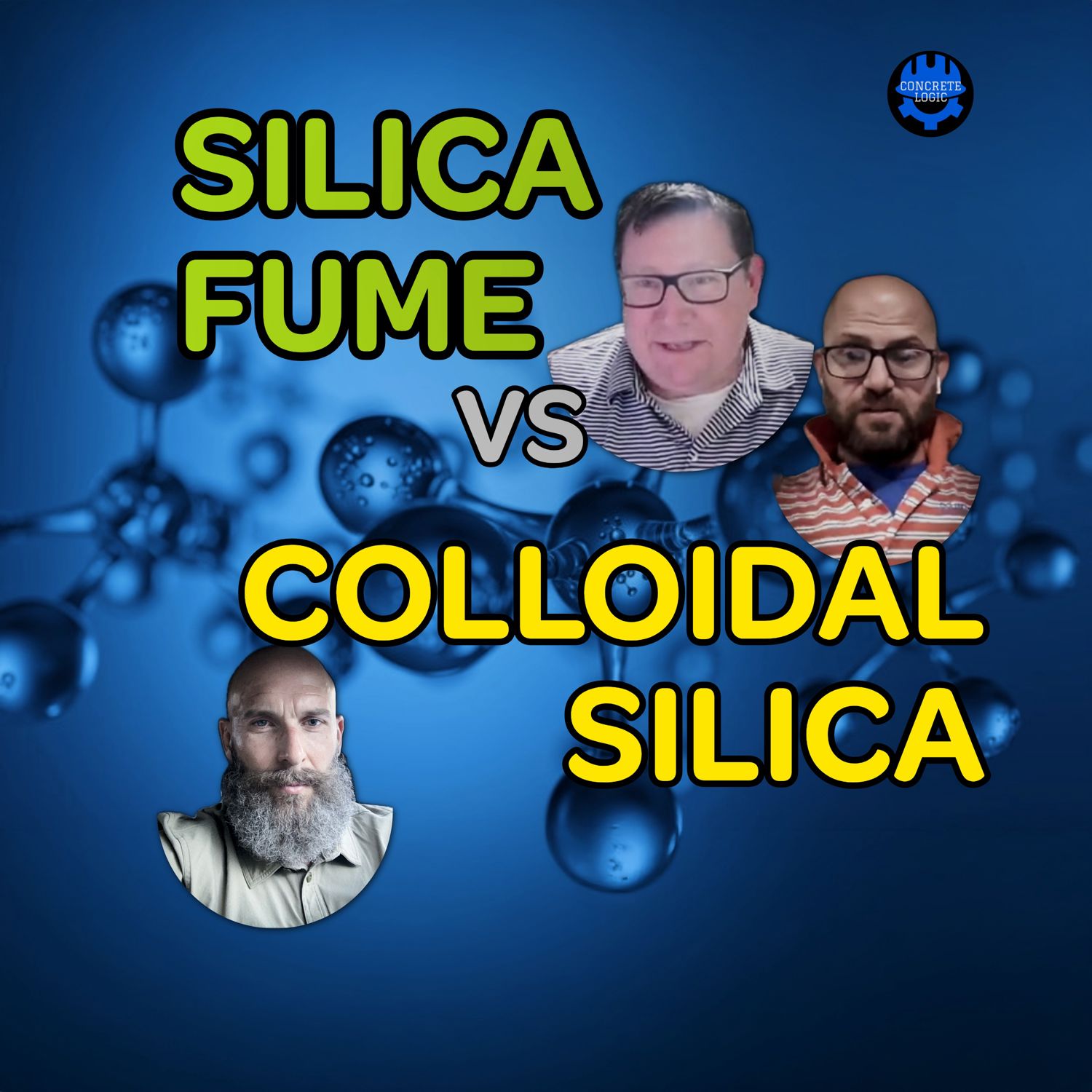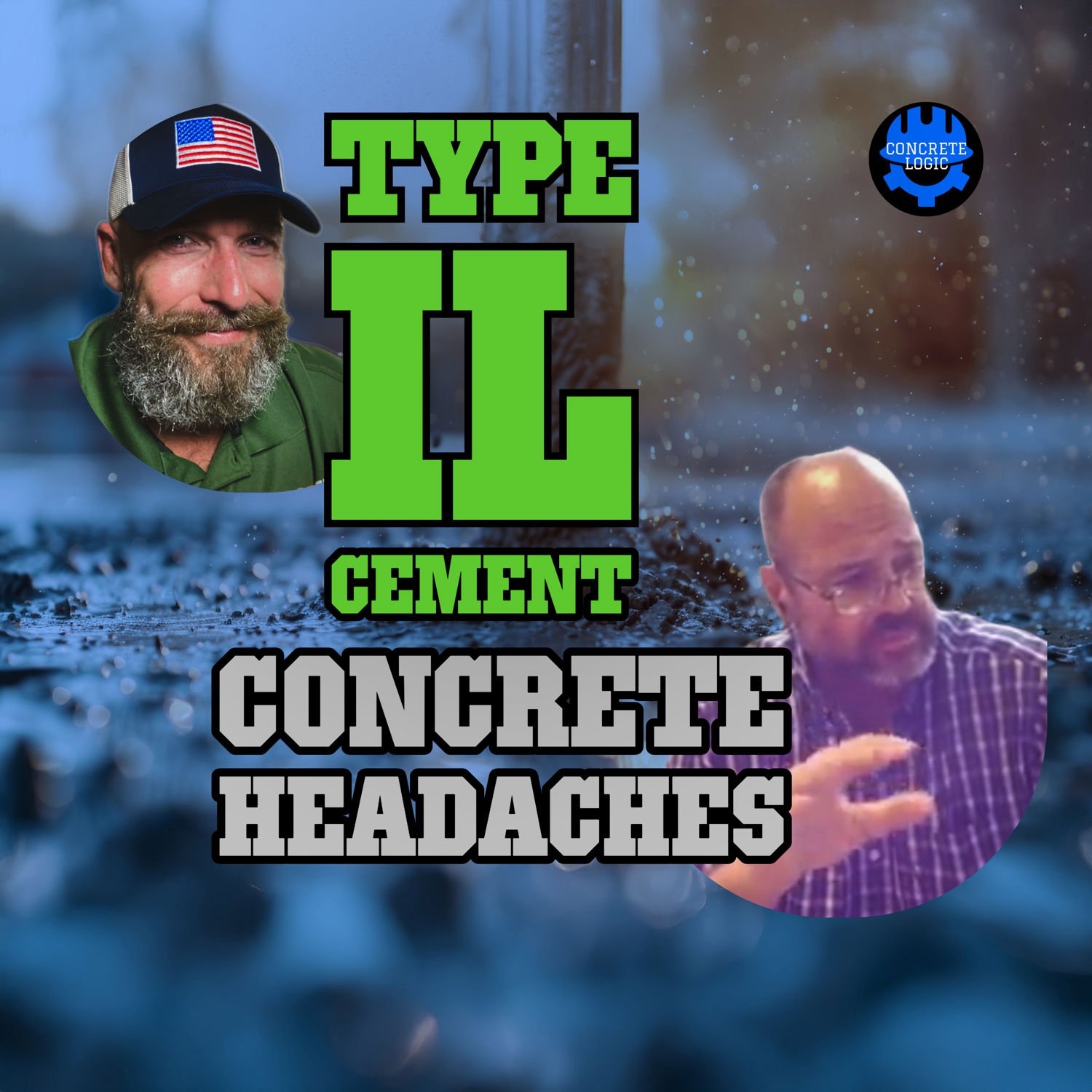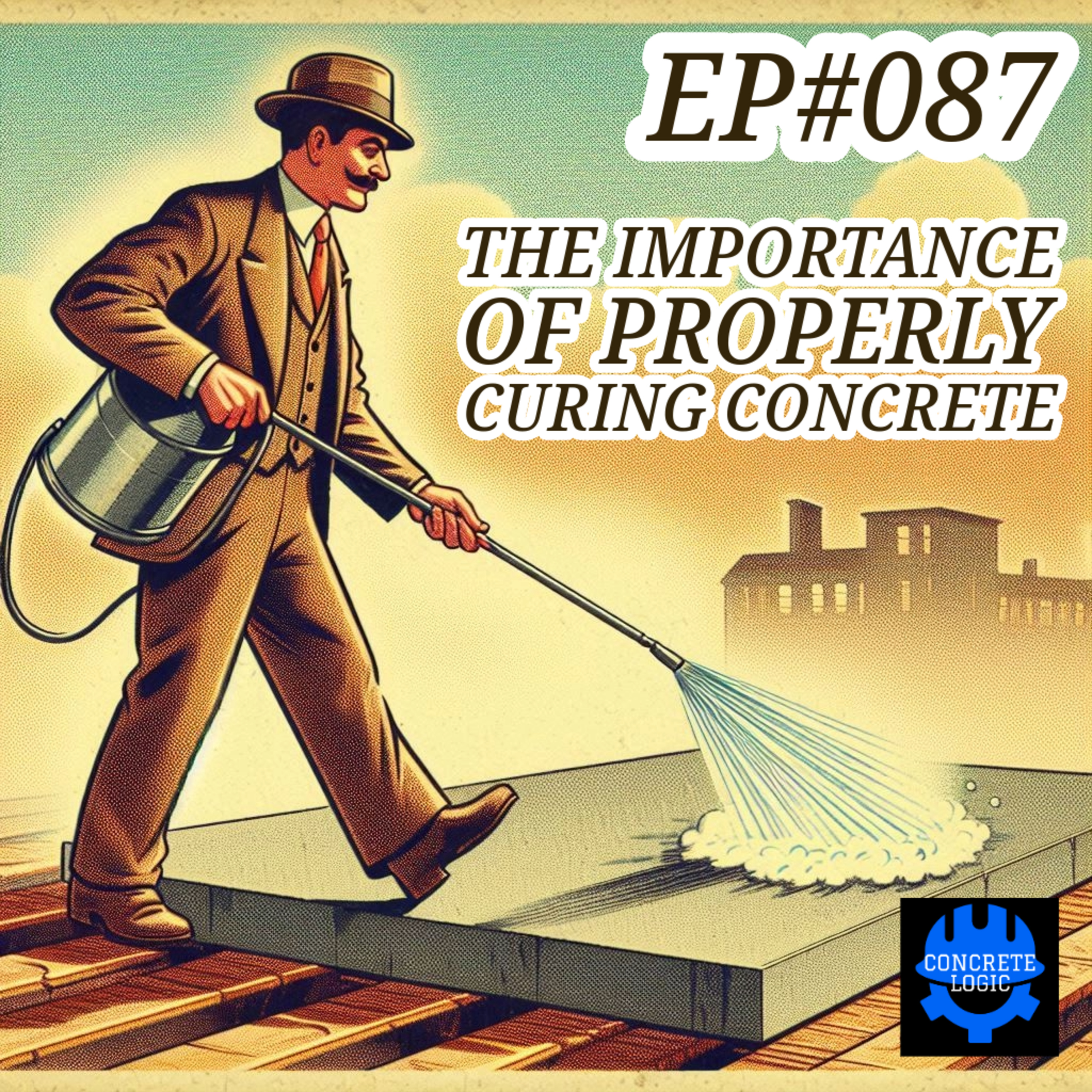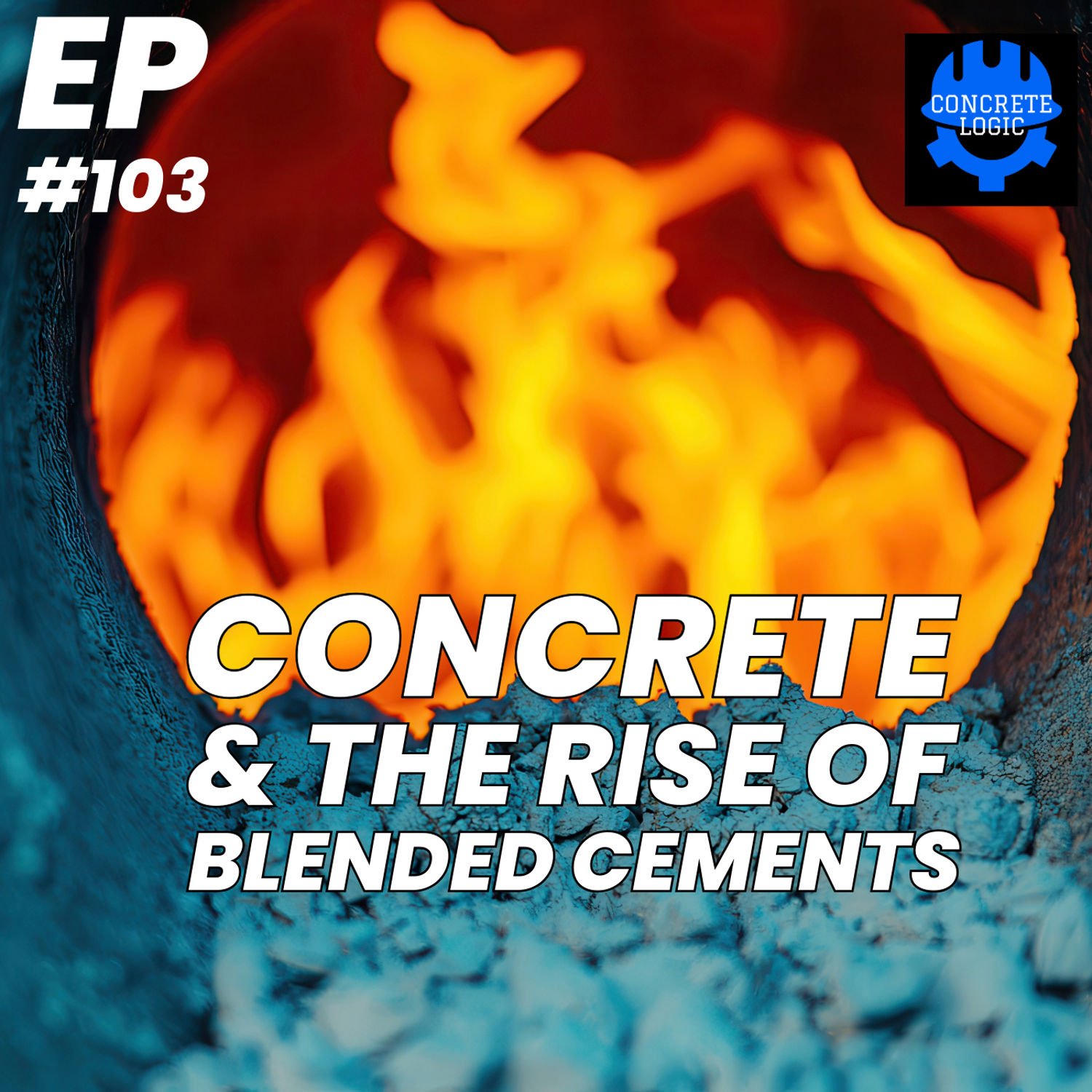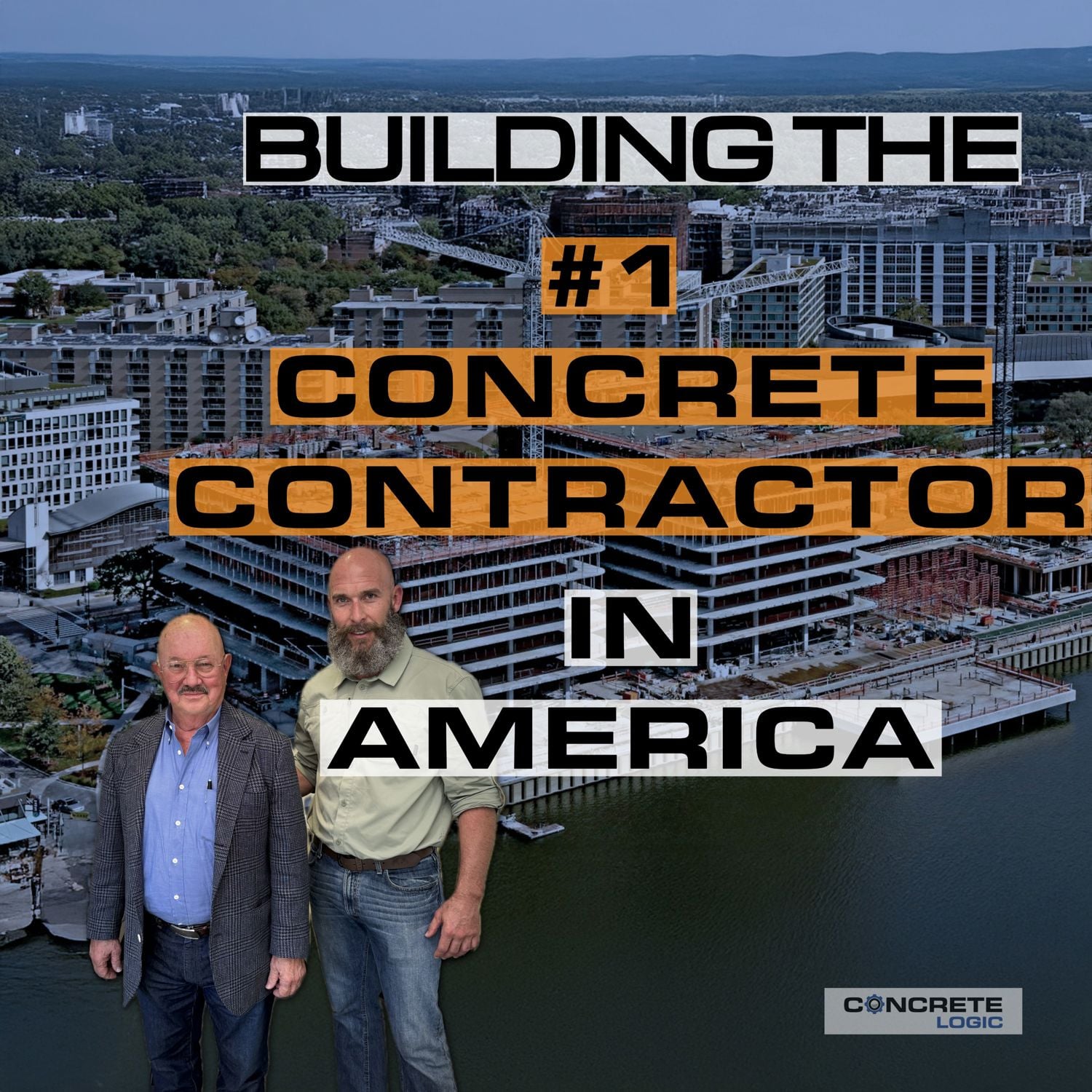EP #124: Concrete Design Disasters: What Every Contractor Must Know

Thinking about designing your own concrete slab—or taking on a proprietary system? You better know what you're signing up for.
In this episode of the Concrete Logic Podcast, Seth Tandett talks with Greg Fricks, CEO of the Fricks Company, about the risks contractors face when they step into the design seat. They cover the legal and financial responsibilities that come with slab design, the fine print in contracts and warranties, and why relying on proprietary systems can come back to bite you. Greg shares lessons learned from decades in the field and lays out what it really takes to build a concrete floor that performs—and protects your business.
What You'll Learn in This Episode:
- Are you unknowingly risking your entire concrete business with every slab design?
- Why does simply following specs protect your concrete company from lawsuits?
- Is your subcontractor agreement secretly stacked against you?
- Could misunderstanding engineering methods be quietly sabotaging your concrete floors?
- Are proprietary concrete systems really worth the hidden dangers they bring?
- Is your concrete warranty setting you up for costly surprises?
- How can skipping simple test pours cost you thousands in repairs?
- What happens when last-minute design changes threaten the integrity of your concrete projects?
CHAPTERS:
00:00 Introduction to High Performance Slabs
02:33 Understanding Risks in Concrete Design
08:52 The Role of Contracts and Warranties
15:42 Proprietary Systems and Their Implications
22:38 Navigating Changes in Design and Load Requirements
28:31 Best Practices for Concrete Contractors
LISTEN NOW – Every concrete contractor, architect, engineer, and ready-mix concrete producer needs to hear this one!
Guest: Greg Fricks
Email: gkf@fricksco.com
Company: The Fricks Company
Website: https://fricksco.com/
=============================
Take Your Knowledge Further – Join Concrete Logic Academy!
Gain exclusive access to expert video courses, live Q&A, and cutting-edge industry insights. Earn Professional Development Hours (PDHs) and elevate your expertise!
Learn More: https://www.concretelogicacademy.com
Support the Podcast – Be Part of the Concrete Revolution!
Donate: https://www.concretelogicpodcast.com
Become a producer & get recognized on our next episode!
=============================
Producer: Jodi Tandett
Music by: Mike Dunton
Instagram: @Mike_Dunton
Stay Connected & Watch More!
Host: Seth Tandett
Email: seth@concretelogicpodcast.com
LinkedIn: https://www.linkedin.com/in/seth-tandett/
YouTube Channel: https://www.youtube.com/@concretelogicpodcast
Podcast Website: https://www.concretelogicpodcast.com
LIKE, SUBSCRIBE, COMMENT & SHARE for more expert concrete insights!
00:26 - Introduction to High Performance Slabs
02:59 - Understanding Risks in Concrete Design
09:18 - The Role of Contracts and Warranties
16:08 - Proprietary Systems and Their Implications
23:04 - Navigating Changes in Design and Load Requirements
28:57 - Best Practices for Concrete Contractors LISTEN NOW – Every concrete contractor, architect,…
Seth Tandett (00:02.638)
And welcome to another episode of the Concrete Logic Podcast. And today I have Greg Fricks, CEO of the Fricks Company. Today we're going to be breaking down what really takes to design and guarantee a high performance slab, why some floors fail before concrete even hits the subgrade, and the risk you take on when you, you know, you pick one of, or you design your own floor.
Greg Fricks (00:03.406)
Thank you.
Seth Tandett (00:31.278)
So if you're in the industrial floor industry, concrete floor industry, I'm sure you've heard of Greg Fricks. You see Fricks floor in the specification sometimes. When it comes to, for me, I've seen it with cold storage projects. Greg, if you want to share more about yourself and Fricks,
Please do.
Greg Fricks (01:03.266)
Yeah, so the Pricks Company is owned by myself, my brother, and my son, Ethan. We've been in business. Our father started the company in 1979 and somewhere in the mid 80s he started traveling across the country doing industrial concrete floors. Like most concrete contractors, we grew up in the business. We're out finishing concrete in high school and came into it in the early 90s full time.
And since that time we established ourselves as a national industrial concrete floor contractor, specializing in shrinkage compensating concrete, extended joint floors. We've been doing extended joint floors before anybody even knew what the term meant. So as to date, we've worked in almost every state in the U.S. other than Hawaii and Alaska, and that's more by choice, I guess, for the logistics.
Seth Tandett (01:59.451)
Yeah.
Greg Fricks (02:04.29)
That's who we are.
Seth Tandett (02:04.986)
Yeah. All right. So today we want to talk about, know, as we were talking before we hit record, we wanted to address a risk. Maybe some concrete contractors don't realize they're taking on when they decide they want to design their own floor, right? If you could kind of expand on that in your concern.
and we'll go from there and ask questions as we go along.
Greg Fricks (02:38.414)
Sure. So, you know, as concrete contractors, we all take on a tremendous amount of risk. So much so that we've all become a little bit immune to that risk. We're just so used to dealing with it every day, day in, day out on every project that we do, that we kind of lose sight of how much risk we're taking. And then in my career, what I've seen, every time that there's a dip in the economy,
it's a recession or just a slowdown, short term, long term, every concrete contractor is looking for an edge. When we start looking for an edge, we are taking on more risk and not even realizing that that's what we're doing. So whenever we go in, whenever we do a job, and I don't care if you're doing the paving, you're doing the slabs, the foundations, the walls, it doesn't matter, if you follow those specs to the letter of the law.
you're following the plans, the specifications, and doing everything that they say to do, if anything goes wrong with that concrete at all, the concrete contractor's getting the first phone call. If that were to go into a lawsuit or any other complications, that concrete contractor is involved from day one and all the way through. The fingers get pointed at the concrete contractor as soon as there's a crack, a delamination, a scaling, it's the wrong color.
It doesn't matter that concrete contractors get in the call. When you go in and you change the specifications or offer a solution or a different system to pour in the floor, the paving or anything else, you're increasing your risk tenfold at a minimum. And now it's all your fault.
anything goes wrong with that slab off us. I'll say slab because that's what we do. That's industrial concrete floors is all that we do. So I'll say slab and floors many more times than I'll say paving. But these floors and these high volume distribution centers are very, very important to the operation for the life of that facility. So the customer expects everything to be perfect.
Greg Fricks (04:57.73)
with no issues, no cracks, no curling. And they also look at modeling or discoloration as a problem because they don't understand in a lot of cases. And sometimes a more educated owner is more dangerous than a non-educated because they've had good floors, that they've had successes, and they know what they want and what they expect. And they think they know how to get there. But also, if anything is not what they expect,
These big corporations are out for blood and their contract is with the general contractor and then as concrete subs, our contracts are with the general contractor. And in many cases, those contracts don't protect the subs to the level that they should. The contracts coming from the general contractor are written to protect them. And that's all well and good and I respect that.
But as subcontractors, not just concrete contractors, subcontractors need to learn how to read those contracts and manage those contracts to protect them just as much as it's protecting the general contractor. You know, like I tell a lot of our clients and whenever I say clients, right now I'm talking about the general contractor because that's who we're working for. That is our client and we respect that and want to work together. But when they put our name on that contract, it's as much...
That contract is as much our contract as it is theirs. And that's what a lot of people in this industry miss. That contract is there to protect both parties and the third party, the owner. But there needs to be as much language in that contract protecting the subcontractor as it does the contractor. And learning how to read those contracts, learning how to...
change language in those contracts or in some cases get some of that language taken out because it is so detrimental to the life of that subcontractor if anything at all goes wrong. So whenever we go in and we suggest alternate solutions to the floor system and our risk goes up exponentially, we need to make sure that contract is written so that we have the protection required. Yes, we need to stand behind it. Yes, that system needs to perform.
Greg Fricks (07:25.694)
And anything that fails because of our performance, absolutely, 100 % our responsibility. But that right there is the case I'm talking about. If that slab system fails that you have suggested or you have offered up to the general contractor and the owner,
You're standing behind that. You're standing behind the concrete performance, the engineering performance, the load performance, everything that can and will go wrong with that slab is now on the concrete contractor's shoulders because he can't turn to the engineer of record. He can't turn to anybody else other than the proprietary system provider. And that's a lot of risk that
most concrete contractors don't consider before they do that.
Seth Tandett (08:23.78)
Yeah. I was going to say, since you're designing the slab, we get, can we get whatever those designer agreements look like? Because every time something comes up on the job, not every time, I shouldn't say that, but a lot of the times, if something comes on the job, the, there's never like, see a structural engineer raise his hand and said, that was me. I screwed up and I'll, I'll take this one on. I mean, that is rare, right?
Greg Fricks (08:38.83)
Okay.
Greg Fricks (08:52.33)
Yeah, I've never seen it in my 35 year career. We deal with a lot of great engineers and we have engineers that design the loads for our floors and they all do things to protect themselves as we do. There's a lot to be learned if you sit down and talk to an engineer and understand how they come up with their solution.
Seth Tandett (08:55.194)
Ha
Yeah.
Greg Fricks (09:20.204)
you start to understand the risks that we're taking and it helps you.
come up with a solution in your contract and helps you define the risk that you're taking as a contractor. know, these, what I'm gonna call proprietary systems that are on the market. You know, there's been a big push. We've been in the extended joint floor system world for 40 years. That's what we've done since the mid 80s. And over time,
been a lot of different systems that have come and gone from the market of people trying to compete with that jointless or extended joint system. And you have a lot of independent companies or companies that are developing a system and then going out to the market and selling that system to the end user and the concrete contractor. What we've seen is they've had the most success going through the concrete contractors.
and getting concrete contractors to sign up as quote unquote, qualified installers of that system. Then they're providing all the materials that are gonna go into that system, meaning the chemicals in the concrete, the reinforcing for that system, and the engineering.
And some cases they're using different engineering methods that are not common in our industry, meaning they're using the Shintu or the Meyerhoff. And you can look into those. You can go on the internet, look up both of those systems and understand how they do the engineering. But the Finite is the only one that does not accept cracks. The Shintu and the Meyerhoff, in those engineering solutions, they accept cracks.
Greg Fricks (11:15.434)
I've never met a client that accepts cracks. And in those two engineering methods, what they do is they accept warping. And when you accept warping in concrete, you're going to get cracks because concrete does not warp. Rebar warps, but concrete does not. And whenever you bend concrete, it cracks. So you have all of these different things that go into this proprietary floor system.
and they're selling that to the concrete contractor and then the concrete contractor is convinced in the gentle contractor and the end user to buy this extended joint or joint control jointless system.
Now you've introduced another party into that. So anything goes wrong with that floor, there are multiple fingers to be pointed. And who's going to stand up? What is the, at the end of the day, how much water does that warranty carry? And does everybody trust where they come to the table and help solve the solution?
in most cases or a lot of cases, the concrete contractor ends up being hung out to dry. And I encourage every contractor that's going to take on one of these systems, I encourage the concrete contractor and the general contractor and the owners to learn everything they can about it and do their research to find out how, what problems there's been, because we all have problems, and how did those problems get solved.
detail-wise. How was it, how was it, was it, were they fixed? Who ended up taking care of it and how much pressure had to be applied to get those fixes taken care of? And then the concrete contractors, know, I encourage every concrete contractor in the world to learn all that they can about their product. Learn everything that there is about the system. Do testing. Like when we do a floor,
Greg Fricks (13:27.694)
The rock sand and cement is sent to us and we put them up and do mix designs. We test it. And you've got concrete contractors out there installing systems that they've just heard about and never seen installed, never even seen it in a finished state that are going out there and they might do a test pour the day before, but then they're pouring 20, 30, 40,000 square foot at a time and they've never even worked with that.
design. And a lot of the extended joint systems are putting a lot of products in that concrete to get it to perform the way that they've designed it to. Whether that's shrinkage reducing admixtures, retarders, curing agents, there's a lot of different things that, as you well know Seth, that can go into that concrete that can drastically change the
everything about the all aspects of the performance of that concrete the fluid state how it's going to be poured the finishing of it how long it's going to be cured the shrinkage the curling there's a chemical for everything that you can imagine to be put in concrete to perform the way you want it
Seth Tandett (14:43.814)
Yeah. Even things that you don't need. Yeah, those are excellent points. By the time this one comes out, we will release another episode about this exact subject about the shrinkage compensating concrete mixes and things like that.
Greg Fricks (14:47.424)
Yeah.
Seth Tandett (15:13.446)
So this is great timing. So a couple things, with your floors or any other extended joint or jointless floor, are you taking on a maintenance program as well when you put these floors down? I mean, is the warranty period longer when you put down?
a floor like that. I mean, what else is the concrete contractor maybe signing up for they they don't understand.
Greg Fricks (15:52.248)
Well, in most cases, for what we've seen with the extended joint systems, the owners require a three to five year warranty. And the way that we put it is that the joint fill is only warrantied for one year if maintained by the owner. Because we look at the joint fill, that is something, it's almost like the oil in your car. It's gotta be changed. If you don't maintain it and you don't change it,
Seth Tandett (16:01.382)
Okay.
Greg Fricks (16:21.932)
the engine's gonna blow up. And if you don't maintain the joint filler, whenever it's not performing, then that joint will start deteriorating, the joint's gonna blow up. So our warranty's written that the joint fill is one year if maintained by the owner during that period, and then we do a one year walkthrough. And then depending on the client or what's been negotiated, our warranties are three to five years.
Seth Tandett (16:23.028)
huh.
Greg Fricks (16:51.15)
I know that most of the proprietary systems offer warranties, but I would encourage you to take that warranty to an attorney that you trust and get them to read it and see that you're going to get the protection that they are proposing that you're to get. If you spend any time at all reading contracts,
Contract language it takes time to learn how to read between the lines and see what they're actually trying to get to You know, we were reading one you had some podcast recently about AI and using AI to your advantage, you know, we had some language recently that was very confusing So we took it and put it in chat GPT and it broke it down for us. It's like oh Wow, it says that well, that's not that doesn't help. That's not good for us
So it's taking the time to learn how to do that. And I strongly suggest that anytime somebody gives you a warranty, you spend some time reading it and understanding it. If you don't understand it, you get somebody to help you learn how to read between the lines.
Seth Tandett (18:00.464)
Yeah. so warranties a little bit longer. I mean, if you typically on a normal job, say, you you just go by the specs and the drawings, a typical warranty is a year long. So, right. You show up a year, you know, short of a year, walk the job to give you a punch list, fix anything, if there's anything that needs to be fixed and then you're off the hook.
Greg Fricks (18:03.694)
about it.
Greg Fricks (18:18.862)
Correct.
Seth Tandett (18:30.36)
after the year. So when you're designing your own slab or taking on somebody else's design and replacing what's in the specs and the drawings, just recognize that you're taking on a longer commitment there as far as with the owner. And then also with these proprietary
designs, is there other costs that maybe concrete contractors aren't aware of? Is there other insurances that you may need to get or anything like that that is atypical of a just going by drawings and specs?
Greg Fricks (19:19.406)
You know, so let's address the comment that you just made after one year off the hook. You know, technically speaking or contractually speaking, yes, once the warranty ends, are, quote, unquote, off the hook. But your reputation isn't. You know, like what I like to say is that floor carries our brand for the life of the facility. And if that floor fails after one year, let's just assume it's a one year warranty.
If it fails after one year and we don't go back as concrete contractors and take care of that or help fix the issue or come up with a solution, then that damages our reputation, damages our brand, and that keeps us from getting the next jobs down the line. That can hurt with that end user and that general contractor that you're working for that you have that relationship with.
He's dealing with multiple owners that now you may not have a road into because you did this one job for this one owner, this one proprietary system that's not performing and you didn't go back and take care of it, even if it's after the warranty. And any good contractor, and I don't care what trade that is, any good contractor is going back and taking care of issues after the warranty period within reason.
So with the proprietary systems, again, getting the contractors to understand what's in it and how that's going to perform. do 90 % of what we're doing is design-build, and we're working with our engineers. doing that, especially in the developer-based properties.
Excuse me. They're always trying to come back and change the rack configuration. You know, we were given the point loads and the live loads and we designed the floor for that. Let's just say it's an eight inch floor based on a single rack, five level high rack system. Then the client that's going to take over that facility and stock that facility wants cantilevered racks. Well, that drastically changes the point loads.
Greg Fricks (21:45.538)
And in most cases, now that to carry the same amount of weight, that needs to be a nine inch floor to handle that cantilever rack. And it's amazing how many times they try to cram that down our throat and get us to sign off.
Because we've been educated, because we understand how that works and the risk associated with that, we will not do that without the engineer being involved.
Then you have, so you need to understand that, you need to understand the engineering behind the system to carry the point loads for that facility. Then how are the joints treated? Because a jointless system still has construction joints. You still got construction joints at the doors.
thinking of a cold storage facility and if you've got a 500,000 square foot dry storage facility, the most you're gonna go is 200 feet and then you're gonna have a joint. Well, with conventional concrete, you're still gonna get curling and that curling's being pushed out further and the further you push curling out, the greater the curl factors are and that occurs at the construction joints. If you don't have proper load transfer devices there,
to handle those loads, that joint's gonna deteriorate very rapidly. Are there armored joints there to protect that joint? How is the joint filler gonna perform in that? Because in some cases, if that curling is so drastic and the shrinkage at those joints is so drastic, the joint fill won't make it a year, especially if you put it in too early. But even with the owner trying to maintain it, that joint fill's gonna fail.
Greg Fricks (23:37.824)
and you're going to have to be in there replacing that joint fill or touching it up, but more than likely replacing it. So it's understanding how are those joints are going to perform and what is there to protect those joints for the life of that facility.
Seth Tandett (23:53.37)
Yeah. So going back to your point about the warranty and fixing things that may come up beyond the warranty period, I think your point is well made and it doesn't even, I think that applies to not just your proprietary systems, but also your normal traditional
build by spec, the specifications and the drawings. So you know what you're putting down and potential issues down the road. it's, but I think a lot, I would say a majority of the concrete contractors out there aren't digging into that, right? They're just, they're going through the motions and doing the, hey, we got a job, let's get the smittles done, get them pushed through.
Greg Fricks (24:27.662)
That's it.
Seth Tandett (24:50.918)
They need us to get started on a certain date and it's coming up on us quick. We don't have time to actually study what we're actually putting down. I mean, that's a great risk that you're taking on blindly, right? You're not studying the materials that you're using to put down. And then going back to your... I'm sure in your business, you've come across these developers that are doing these...
Greg Fricks (25:04.93)
Yeah.
Seth Tandett (25:20.88)
these speculative buildings, right? They don't have a tenant per se. They want to build a cold storage facility and then they may have one tenant or multiple tenants that are going to use that facility. they changed the, like you said, the racking system or whatever. And I imagine you would have to, if you're using your design,
that you kind have to spell out, hey, this is the floor that we're installing and this is what it's designed for, like an owner's manual and they hand it over to the owner and say, hey, this is what we gave you. If you do anything beyond this, it's on you, right?
Greg Fricks (26:09.204)
Absolutely, we do. Yes. you know, this, the whole developer based cold storage, that was a whole new market for us. And we had, is a learning curve for us because they have, we've never had an owner come back and say, Hey, we're going to completely change the racks. They move them. Well, you know, we've had a moved, but to come back and say that, Hey, we're going to change the configuration of the racks. And a case in point of what you're talking about right now is we have one job for a client.
that is eight inches and now we're doing a new facility, same point loads that has to be nine because the soil's aren't as good. And that developer is up in arms going, no, we want eight, you have to do eight. Okay, we can do eight, that's great, but we can't meet the same point loads that we did on the previous job.
And he doesn't understand that, or maybe he does understand it, and he's just trying to cram it down our throat. But it's having the education and the knowledge to stand up to that and prove up why one is eight and this one has to be nine. And then whenever they call up and say that they want to go from a single pushback to a double pushback, explaining to them, being able to explain to them how those point loads have just changed drastically, and you're not going to be able to put as much weight.
Seth Tandett (27:36.016)
So just to kind of summarize what we're talking about today. if you're considering using your own design or a proprietary floor system that someone is ask you to get certified to put down, the steps to kind of mitigate your risk would be first to...
Greg Fricks (28:02.862)
be first to do test, test, uh, course, sorry, yeah. No, I can, I can, I'd say the first steps is learn all that you can about it. Do your research on it. Don't just sign up for it and certainly don't pay the initiation fee until you've done enough research to find out what successes they've had with it and what failures they've had with it. You know, we all, it's human nature to just look at the negatives and research that.
Seth Tandett (28:05.712)
test, test, pores, sorry, getting out.
Greg Fricks (28:31.704)
Well, some of these have been successful, but where have they been successful? Under what circumstances have they been successful? And also what part of the country is it? You know, a system that works in Chicago where the ready mixed materials are very forgiving is not going to work as well in Southern California where you have extreme environment and extreme dry environment.
and the concrete materials in that area are high shrinkage. So that proprietary system that performed very well in Chicago or the Midwest is not going to perform the same on the far west coast. So it's understanding what successes and what failures they've had and whenever there was a failure, how did they get involved? What did they do to help mitigate those problems?
And then also if you sign up for it, learning everything that there is in that concrete and doing test pours way before the job starts. Most of the time when somebody's taking on a proprietary system, they're also the total package concrete contractor on the job. Place that system in some areas that just don't matter. Meaning mud slabs or an area that you could tear out or in office areas that you can get covered.
but try to place that in other areas so that you can learn as much as you can about it and then try to get the proprietary developer of that system to tell you everything that there is in that concrete and how just a temperature change is going to affect the performance of that slab. Because if you're, know, well, right here in Texas, you know, we were running, the temperature was in the high 40s.
low 50s and then all of a sudden in one week's time we shot up to 103 in just seven days. Well, that drastically affected the performance of the concrete that day and actually the next few days following that. And if you don't understand the system, you don't understand what's in that concrete, you're not going to be able to adjust it accordingly to get the same performance.
Seth Tandett (30:28.219)
Mm.
Seth Tandett (30:53.124)
Yeah, that I think yeah, this was this was great Greg. I think you brought some great points up today and if If folks want to reach out to you and learn more about pricks, what's the best way?
Greg Fricks (31:10.922)
Either go to our website or you can get me on my email at gkf at fricsco.com.
Seth Tandett (31:20.72)
All right, Greg, thank you for coming on the show today. I appreciate it.
Greg Fricks (31:26.668)
Yeah. Thank you, Seth. I appreciate you inviting me on the show. It's been, I've really enjoyed listening to your past podcast and
feel honored to be a part of this. So thank you.
Seth Tandett (31:36.167)
Thank you and folks until next time let's keep it concrete.

Greg Fricks
CEO
Greg Fricks is the CEO of The Fricks Company, a nationally recognized leader in industrial concrete floor construction. A lifelong resident of Fort Worth, Texas, and a graduate of Texas Tech University, Greg has dedicated over 35 years to advancing the standards of durability, precision, and performance in industrial concrete floors.
The Fricks Company has become the nation’s go-to expert in single-source, design-build industrial concrete floor construction, serving many of the most well-known brands in food distribution, cold storage, and material handling. Greg is known for his deep technical knowledge, commitment to innovation, and focus on long-term client relationships.
Through decades of hands-on experience and strategic vision, Greg continues to guide The Fricks Company in setting benchmarks for quality and reliability in the concrete construction industry.









